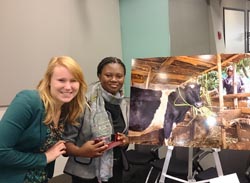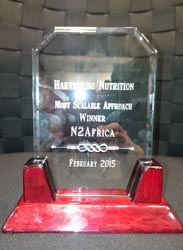|
In 2012, The World Bank Group launched the SecureNutrition Platform to bridge knowledge gaps between agriculture, food security and nutrition. Together with Global Alliance for Improved Nutrition (GAIN) and Save the children UK, the SecureNutrition Knowledge Platform’s 2013 Harvesting Nutrition contest was initiated to showcase projects that link agriculture, food security and nutrition and their challenges. Photo: Ilse de Jager and Theresa Ampadu-Boakye showing the award won by N2Africa |
 |
The contest attracted 50 submissions from projects around the world seeking to showcase their efforts to improve the impact of agriculture and/or food security interventions on nutrition outcomes (have a look at the website to learn about many interesting projects. N2Africa was selected as one of the winners for the most scalable approach!
 |
On 18th and 19th February 2015, the three winning projects were invited to attend the Harvesting Nutrition Celebration event hosted at the World Bank, Washington DC and we (Theresa Ampadu-Boakye and Ilse de Jager) were selected to attend this two-day programme as representatives of N2Africa. Wednesday 18 February, all three projects presented their projects among a small group of technical experts. Relevant details of N2Africa and the results of nutrition research that has been conducted within N2Africa were shared with the group. This resulted in interesting discussions afterwards which are highlighted below among the take homes.Thursday 19 February, the official award ceremony took place including video and photo portraits of the award-winning projects RIAN (as winner for Potential Impact on Nutrition), Shaba Shape Up (Innovation) and N2Africa (video), featuring Speciose Kantengwa and Samuel Adjei-Nsiah), a panel discussion and a keynote presentation by Dr. Derek Yach. The event was livestreamed on World Bank Live. Check the webcast available for replay here and a short decription of the 3 winners here. |
Some interesting take home messages from the event:
- What activities can be implemented (and are effective) by an agriculture project like N2Africa to make it more nutrition-sensitive (but at the same time staying close to core activities and expertise)? Ideas out of discussions:
- Identify and educate participating beneficiaries on nutritional aspects, not only legumes but on the complete diet (increase crop diversity, strengthen the income to nutrition pathway). Collaboration with nutrition specific staff/organisations instead of training extension agents to also learn about nutrition.
- Identify and develop value added legume-based products that can easily be accessed and prepared by targeted rural households and simultaneously are of commercial value.
- Develop strong social structures which has been identified to have strong link with nutrition, for example develop farmer groups to facilitate empowerment of women and/or creating access to commercial markets.
- Women empowerment in relation to specific gender constraints in the various value chains, for example access to financial support and/or training how to manage loans.
2. What can be measured (evidence based) as contribution to nutrition by agriculture projects?
- Stunting (chronic malnutrition) is a ‘high-level outcome’ which is impossible to be influenced by an agriculture project alone. Stunting is a result of many different factors of which agriculture is just one underlying factor. Therefore it is probably better to focus on including indicators like dietary diversity within agriculture projects which are more plausible to be effected by an agriculture project, directly or indirectly. Potential relevant nutrition indicators for N2Africa:
- Individual dietary diversity score of children and women (vulnerable groups)
- Iron status of children and women (high iron beans variety being distributed in Uganda)
- Quantitative dietary intake assessment (to identify problem nutrients and contribution of legumes to the diet)
- Frequency of legume consumption
- Research on underlying steps of pathways linking agriculture and nutrition is needed.
Ilse de Jager and Theresa Ampadu-Boakye
